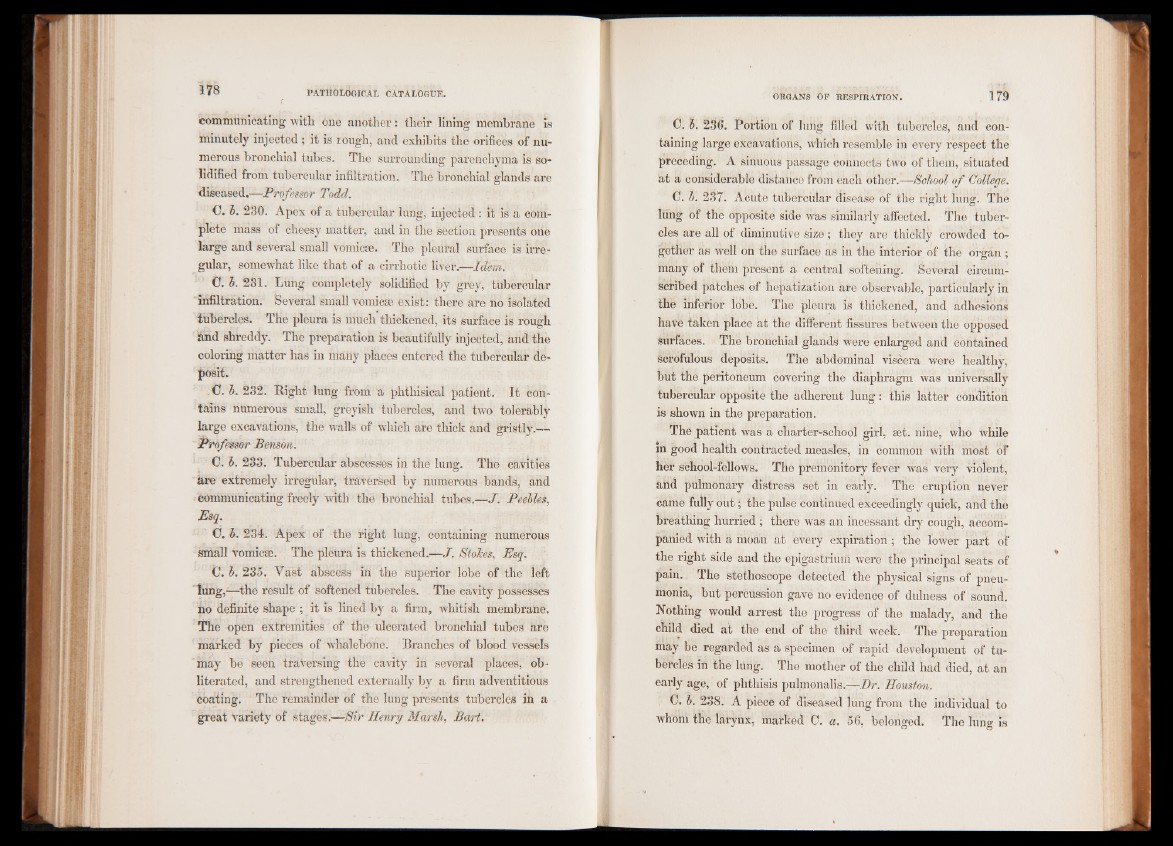
communicating with one another: their lining membrane is
minutely injected; it is rough, and exhibits the orifices of numerous
bronchial tubes. The surrounding parenchyma is solidified
from tubercular infiltration. The bronchial glands are
diseased.—Professor Todd.
C. b. 230. Apex of a tubercular lung, injected : it is a complete
mass of cheesy matter, and in the section presents one
large and several small vomicae. The pleural surface is irregular,
somewhat like that of a cirrhotic liver.—Idem.
C. b. 231. Lung completely solidified by grey, tubercular
infiltration. Several small vomicae exist: there are no isolated
tubercles. The pleura is much thickened, its surface is rough
and shreddy. The preparation is beautifully injected, and the
coloring matter has in many places entered the tubercular deposit.
C. b. 232. Right lung from a phthisical patient. It contains
numerous Small, grfeyish tubercles, and two tolerably
large excavations, the walls of which are thick and gristly.—
Professor Benson.
0 . b. 233. Tubercular abscesses in the lung. The cavities
are extremely irregular, traversed by numerous bands, and
communicating freely with the bronchial tubes.—J. Peebles,
Esq.
0. b. 234. Apex of the right lung, containing numerous
small vomicae. The pleura is thickened.—J. Stokes, Esq.
C. b. 235. Vast abscess in the superior lobe of the left
lung,—the result of softened tubercles. The cavity possesses
no definite shape ; it is lined by a firm, whitish membrane.
The open extremities of the ulcerated bronchial tubes are
marked by pieces of whalebone. Branches of blood vessels
may be seen traversing the cavity in several places, obliterated,
and strengthened externally by a firm adventitious
Coating. The remainder of the lung presents tubercles in a
great variety of stages.—Sir Henry Marsh, Bart.
0. b. 236. Portion of lung filled with tubercles, and containing
large excavations, which resemble in every respect the
preceding. A sinuous passage connects two of them, situated
at a considerable distance from each other.—School of College.
0. b. 237. Acute tubercular disease of the right lung. The
lung of the opposite side was similarly affected. The tubercles
are all of diminutive size; they are thickly crowded together
as well on the surface as in the interior of the organ;
many of them present a central softening. Several circumscribed
patches of hepatization are observable, particularly in
the inferior lobe. The pleura is thickened, and adhesions
have taken place at the different fissures between the opposed
surfaces. The bronchial glands were enlarged and contained
Scrofulous deposits. The abdominal viscera were healthy,
but the peritoneum covering the diaphragm was universally
tubercular opposite the adherent lung : this latter condition
is shown in the preparation.
The patient was a charter-school girl, set. nine, who while
in good health contracted measles, in common with most of
hèr school-fellows. The premonitory fever was very violent,
ahd pulmonary distress set in early. The eruption never
came fully out; the pulse continued exceedingly quick, and the
breathing hurried; there was an ihcessant dry cough, accompanied
with a moan at every expiration; the lower part of
the right side and the epigastrium were the principal seats of
pain. The stethoscope detected the physical signs of pneumonia,
but percussion gave no evidence of dulness of sound.
Nothing would arrest the progress of the malady, and the
child died at the end of the third week. The preparation
may be regarded as a specimen of rapid development of tubercles
in the lung. The mother of the child had died, at an
early age, of phthisis pulmonalis.—Dr. Houston.
0. b. 238. A piece of diseased lung from the individual to
whom the larynx, marked C. a. 56, belonged. The lung is